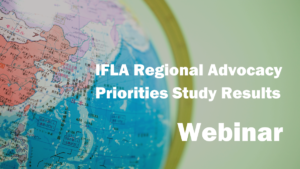Recording and Slides now available for the IFLA Webinar: Lessons from the Library Advocacy Priorities Study
14 December 2021

Where and how do libraries advocate? What activities are libraries undertaking around the world to achieve their advocacy goals? IFLA’s webinar “Lessons from the Library Advocacy Priorities Study” provides a starting point to think about the answers to these questions.
Main themes that came out from the IFLA Regional Advocacy Priorities Study have provided some useful steer to the new IFLA Regional Division Committees, informing their discussions and the actions plans being developed by them, which will soon be published on IFLA’s website.
Trends and outstanding issues
There are indeed differences between regions. We are all of course advocating for libraries, but in different ways and with different tools. The level of development of each region may have an influence on where libraries focus their advocacy on, responding to the needs of the communities that they serve, for example not only economic development but also digital inclusion, society, education, and other factors.
There also seem to be differences between small and bigger players in the field. There is an interesting question here: is it bigger library associations that have a greater capacity to engage in more technical issues, that require specific expertise? Is it possible that smaller library associations, unless they are specialised, tend to focus more on broader issues, rather on more technical ones? It was also apparent from the study that smaller library associations count more on their members as advocates, while bigger library associations tend to be readier to have staff or named advocacy leads, and can have greater expertise in technical and complex issues.
Want to know more? Watch the recordings.
The first session took place at 08:00-08:45 UTC and while the presentation covers all regions, there is a focus on the Asia-Oceania region, as well as Sub-Saharan Africa, the Middle East and North Africa, and Europe.
The second session took place at 13:00-13:45 UTC and while the presentation covers all regions, there is a focus on the regions of Latin America and the Caribbean and North America, as well as Sub-Saharan Africa, the Middle East and North Africa, and Europe.
Click on the picture below to download the PowerPoint slides for each webinar.
Lessons from the Library Advocacy Priorities Study - Webinar 1
IFLA’s Regional Advocacy Priorities Study draws on results to a survey to provide a starting point for thinking about where and how we advocate. Webinar 1 offered an opportunity to find out more about the results of the Study, and some of the possible trends and issues it raised.
Lessons from the Library Advocacy Priorities Study - Webinar 2
IFLA’s Regional Advocacy Priorities Study draws on results to a survey to provide a starting point for thinking about where and how we advocate. This webinar explored the results of the Study, and some of the possible trends and issues it raised, with a particular focus on the Americas.